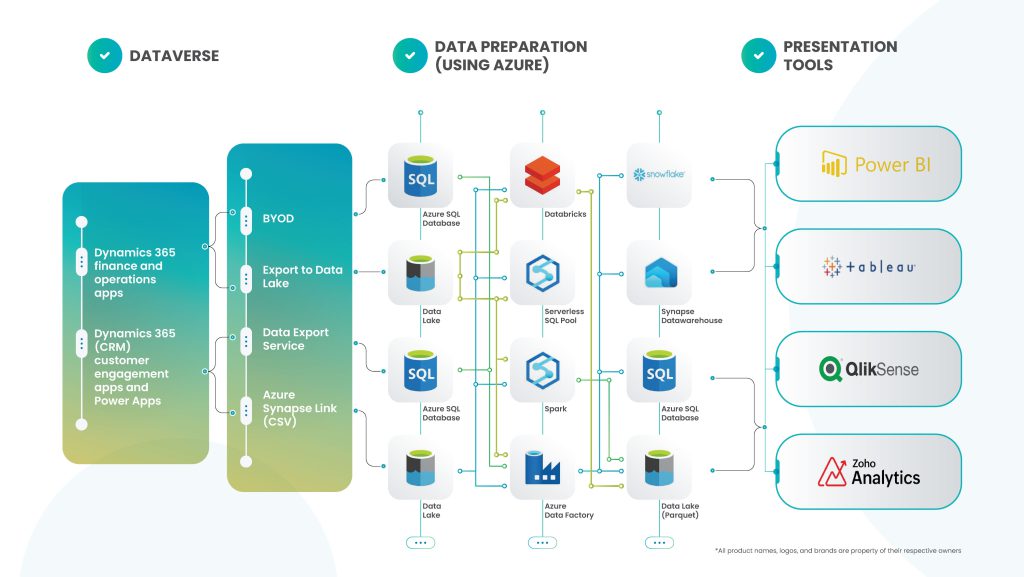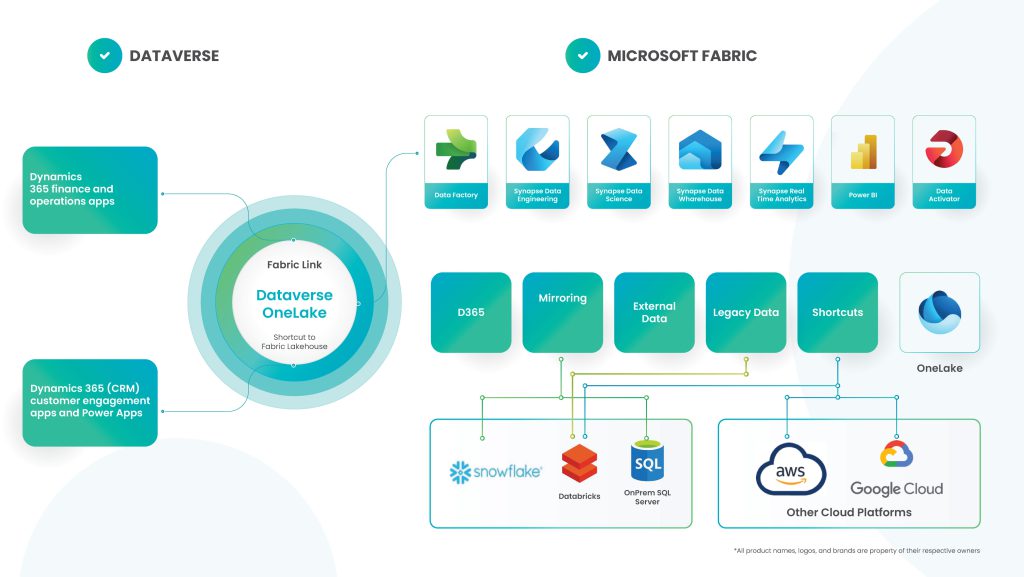Current architectures with fragmented data estate and disconnected business applications delay agility and increase operational overheads. Microsoft Fabric comes with an end-to-end analytics platform that is a revolutionary solution for integrating data and analytical tools into a single environment. When we combine Fabric and Dataverse, where D365 and Power Platform applications are built, it unlocks unprecedented opportunities to streamline data experience and workflows and optimize reporting.
Let’s explore the united power of Microsoft Fabric and Dataverse, highlighting their key benefits, use cases, and architectural considerations for businesses seeking to transform their data landscape.
Power of Microsoft Fabric and Dataverse Together
Microsoft Fabric and Dataverse are powerful platforms individually; their combination gives significant value and enables real-time unified data experiences. Here’s how they work better together:
- Dataverse as a Source for Fabric: Fabric integrates seamlessly with Dataverse, allowing for direct linking with any other data source. By leveraging operational data from Power Platform and Dynamics 365, Microsoft Fabric enhances advanced analytics and data warehousing capabilities. This integration also enables the development of AI/ML initiatives providing a robust platform for data-driven insights and innovation.
- Fabric as a Destination for Dataverse Insights: Microsoft Fabric can write back enriched data to Dataverse, such as aggregated metrics, predictive model outputs and enriched data. This helps D365 and Platform app to use the data in their reports. For instance, we can view and interact with the dashboards related to sales performance and their metrics.
- Data Governance and Security: We can extend their existing data governance and security policies to encompass their entire data estate. Automation tools within Fabric handle routine tasks like data classification, policy enforcement, etc.
- Streamlined Data Pipelines: With Fabric data extraction, loading, and transformation will be automated. It reduces manual intervention, leading to reduced errors and increasing the data processing speed.
- Enhanced Business Intelligence: Power BI within Fabric can directly connect to Dataverse data, enabling the creation of interactive dashboards and reports that offer a holistic view of business performance.
- Accelerated Low-Code Development: With Fabric and Dataverse we can develop intelligent apps using Power Platform and D365. This allows D365 developers to build apps faster and without requiring in-depth knowledge of data engineering or data science.
Current Solutions Deployed with Customers
The following approach shows how data flows from Dataverse to data preparation and presentation tools.

Challenges
- Multiple Data Sources: When dealing with legacy systems or non-Microsoft platforms, integrating various data sources into Dataverse could be complex.
- High Volume of Data: Working with high volumes of data can impact performance, often requiring significant efforts to optimize data models and queries for improved efficiency.
- High License Costs: Managing licensing costs for Dataverse to associate with any analytics platform will be a challenge, especially for large user bases or extensive data needs.
- Source and Target Data Mapping: Accurate mapping and transformation during integration can be challenging, potentially leading to data inconsistencies that result in incorrect reports.
- Resource Allocation: Allocating resources efficiently to manage and maintain Dataverse infrastructure and analytics tools can impact overall costs.
Simplified Solutions with Microsoft Fabric
A simplified data flow shows how two-way integration enables low-code users to do more with data, no ETL and no copy.

OneLake will ensure that data stays within the governance boundaries of Dataverse and the platform allows only authorized users in the Fabric environment. We will benefit from improved query performance and smaller, compressed data sizes, eliminating the need for extra data copies and aggregations.
The Microsoft Fabric toolset simplifies management with integrated billing, source control, and security features. This solution offers Direct Lake mode reports seamlessly integrated with copilots, providing faster insights while needing less expertise.
Reducing Costs by Combining Microsoft Fabric and Dataverse
Combining Dataverse and Microsoft Fabric can drive significant cost improvements, depending on factors such as current infrastructure, usage patterns, and specific implementation strategies. However, there are some potential areas where notable savings can be achieved:
- Reduced Data Storage: By archiving frequently accessed data and using data compression, we can reduce storage costs by up to 50%.
- Data Compression: By compressing data with Microsoft Fabric and Dataverse, reporting and query costs can be reduced by up to 30%.
- Reduced License Costs: Choosing the right licensing plan and optimizing user licenses can save costs upto 20-30%. The cost of ETL services/tools can also be saved.
Scalable Infrastructure: The combined infrastructure of Dataverse and Fabric, with auto-scaling and serverless options, can reduce infrastructure costs by 30-40% by ensuring you are only paying for what you use.
Improved Resource Optimization: Regularly optimizing workloads and right-sizing resources can lead to a 20-30% reduction in resource costs.
Conclusion
Together, Microsoft Fabric and Dataverse represent a powerful proposition for organizations seeking to unlock the full potential of their data. We can build an analytics platform and a robust data foundation for business applications, which will enable seamless data integration, enhanced collaboration, accelerated insights, and, ultimately, better business outcomes.

is the Head of Microsoft Practice for PDES at Happiest Minds. He has 21+ years of experience in the Tech industry and has proven expertise in Presales, Solutioning in Azure, D365, and Power Platform, having implemented complex global solutions leveraging Microsoft Technologies. At Happiest Minds, Pradeep is primarily responsible for business outcomes and is a subject matter expert with Microsoft Technologies.




